The three branches of our government
were established by our Constitution.

THE THREE BRANCHES OF GOVERNMENT
The three branches of our government
were established by our Constitution.

1. THE LEGISLATIVE BRANCH
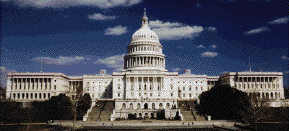
THE CAPITOL BUILDING
CONGRESS
Congress is made up of the Senate and the House of Representatives.
Their job is to make the laws for our country.
The Senate has 100 Members, two from each state.
Senators are elected for 6-year terms.
A senator must live in the state from which he is chosen.
A senator must be at least 30 years of age.
A senator must have been a citizen of the United States for at least 9 years
The House of Representatives is made up of 435 members.
A state that has a big population will have many representatives.
A state that has a small population will have only a few representatives.
Every state must have at least one representative.
Members are elected by the people for 2-year terms.
A representative must live in the state from which he is chosen.
A representative must be at least 25 years of age.
A representative must have been a citizen for at least 7 years.
2. THE EXECUTIVE BRANCH
The executive branch of Government makes sure that the laws of the United States are obeyed. The President of the United States is the head of the executive branch of government. This branch is very large so the President gets help from the Vice President, department heads (Cabinet members), and heads of other agencies.
The President of the United States


President George W. Bush Laura Bush
The President is the head of the executive branch.
He appoints people who are experts in certain areas to be his advisers--his cabinet. Click here to meet President Bush's cabinet.
| He has an important part in making Americas laws. His job is to approve the laws that Congress makes. |
|
When the Senate and the House approve a bill, they send it to the President. |
| If the President does not like a bill, he can refuse to sign it. When he does this, it is called a VETO. If the President vetoes a bill, it probably will never become a law. |
| If Congress really, really wants the law very badly, they can still pass it even though the President said no. But they need a lot of people in Congress to agree to that. Two-thirds of the members must vote "yes". |
| The President cannot write bills. He can suggest (propose) a bill, but a member of Congress must submit it for him. |
| The President has other responsibilities. He serves as the American Head of State. That means that he meets with the leaders of other countries and can make treaties with them, but the Senate must approve. |
|
The President is also the Chief of the Government. |
| Also, the President is the official head of the U.S. military. He can send our troops to other countries. To actually declare war, he must get the approval of the Congress. |
| The President and the Vice-President are the only officials chosen by the entire country. |
| To be President of the United States, one must be at least 35 years old. Each candidate must be a natural-born U.S. citizen. Each candidate must have lived in the U.S. for at least 14 years. |
|
The President serves a term of four years. |
| The President lives in the White House. |

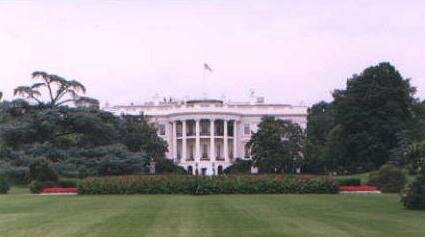
3. THE JUDICIAL BRANCH
The judicial branch of government is made up of the court system.
The Supreme Court is the highest court in the land.
Courts decide arguments about the meaning of laws, how they are applied,
and whether they break the rules of the Constitution.
The Supreme Court
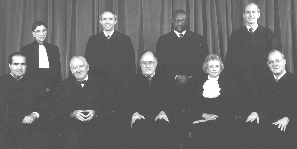
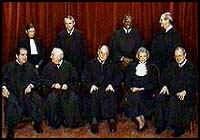
Back Row (left to right): Ginsburg, Souter, Thomas, Breyer
Front Row (left to right): Scalia, Stevens, Rehnquist, O'Connor, Kennedy





Kennedy Ginsburg Breyer Souter Scalia
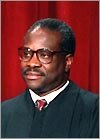



Thomas O'Connor Stevens Rehnquist
The Supreme Court is the highest court in the United States.
The Supreme Court hears cases that have made their way through the court system, but of the more than 7,500 cases that are sent to the Supreme Court each year, only about 80 to 100 cases are actually accepted. Once the Supreme Court makes a decision,
it can only be changed by another Supreme Court decision
or by amending (changing) the Constitution.
This is a very important power that can affect the lives of a lot of people.
The Supreme Court is made up of nine Justices, or judges.
One of these is the Chief Justice.
They are appointed by the President and must be approved by the Senate.
Justices have their jobs for life.

ACTIVITY #1
1. Name the building that is home for the judicial branch of our government.
2. Name the building that is home for the head of the executive branch of our government.
3. Name the building where the legislative branch of our government meets.
4. Name the two parts of congress, the legislative branch. and .
5. Name the head of the executive branch.
6. What do we call the people who make law (legal) decisions in the Supreme Court?
7. How many senators are there?
How many member of the House of Representatives are there?
8. How many Supreme Court judges are there?
9. Which branch makes sure the laws of our country are obeyed?
10. Which branch makes the laws?
11. Which branch decides if the laws that are made are fair and just according to our Constitution?
12. If the President does not like a bill (a proposal for a law) he can it.